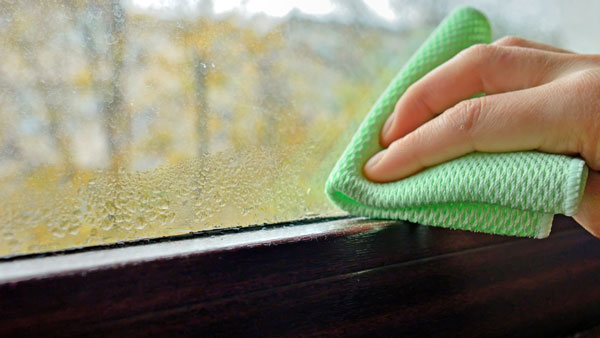
The windows throughout your home are a gateway to the outdoors, a way to draw light in while you appreciate the view of your garden, yard or other surroundings. The last thing you want to see is a sweaty window coated in a coating of condensation.
Not only are windows plastered with condensation unattractive, they also can be evidence of a larger air-quality deficit in your home. Luckily, there’s numerous things you can do to correct the problem.
What Produces Condensation in Windows
Condensation on the inner layer of windows is formed by the moist warm air in your home mixing with the cooler surface of the windows. It’s particularly common around the winter when it’s much colder outside than it is inside your home.
Inside Moisture vs. In Between Panes
When dealing with condensation, it’s necessary to know the difference between moisture on the inside of your windows compared to moisture in between the windowpanes. One is an indoor air quality issue and the other is a window issue.
- Moisture inside a window is caused from the warm damp air in your home condensing along the glass.
- Any moisture you see between windowpanes is produced when the window seal breaks down and moisture seeps between the two panes of glass, in which case the window has to be repaired or replaced.
- Condensation inside the windows isn’t a window situation and can instead be fixed by changing the humidity in your home. Many things cause humidity inside a home, such as showers, cooking, laundry or even breathing.
Why Sweating Windows Could Mean a Problem
Even though you might think condensation in your windows is a cosmetic concern, it may also be indicating your home has excess humidity. If this is in fact the case, water could also be collecting on window frames, cold walls or other surfaces. Even a slim film of water can cause wood surfaces to mildew or rot over time, promoting the growth of mildew or mold.
How to Decrease Humidity Inside Your Home
Fortunately there are numerous options for extracting moisture from the air inside your home.
If you have a humidifier operating inside your home – whether it be a small-scale unit or a whole-house humidifier – lower it further so the humidity inside your home goes down.
If you don’t have a humidifier active and your home’s humidity level is excessive, consider getting a dehumidifier. While humidifiers put moisture inside your home so the air doesn’t become too dry, a dehumidifier extracts excess moisture out of the air.
Small, portable dehumidifiers can remove the water from an entire room. However, those units require emptying out water trays and usually service a small area. A whole-house dehumidifier will remove moisture throughout your entire home.
Whole-house dehumidifier systems are managed by a humidistat, which allows you to establish a humidity level precisely like you would choose a temperature with your thermostat. The unit will start immediately when the humidity level surpasses the set level. These systems coordinate with your home’s HVAC system, so you should contact skilled professionals for whole-house dehumidifier installation Portland.
Additional Ways to Eliminate Condensation on Windows
- Exhaust fans. Putting in exhaust fans near humidity hotspots including the bathroom, laundry room or above the oven can help by pulling the warm, humid air from these rooms out of your home before it can increase the humidity level throughout your home.
- Ceiling fans. Running ceiling fans can also keep air circulating inside the home so humid air doesn’t get trapped in one spot.
- Open window treatments. Throwing open the blinds or drapes can reduce condensation by preventing the humid air from being trapped against the windowpane.
By lowering humidity in your home and dispersing air throughout your home, you can take advantage of clear, moisture-free windows even in the middle of the winter.
